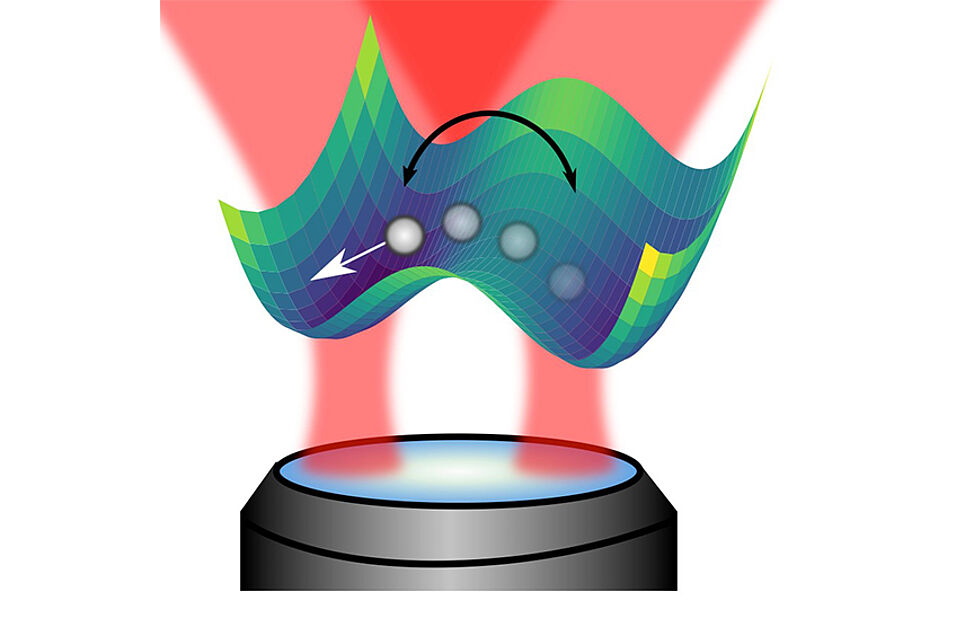Many important natural phenomena, like chemical reactions and phase transitions, represent a system's spontaneous escape from a metastable state. These transition events are induced by large, rarely occurring fluctuations in the interaction with the environment. The Dutch physicist Hendrik Kramers studied the complex interplay between transition dynamics and environmental forces, uncovering the emergence of an maximal transition rate at intermediate friction. Now, a team of researchers from the ETH Zurich and the University of Vienna has demonstrated how the orientational decorrelation timescale plays a similar role for the escape dynamics of actively propelled particles. Reporting their findings in Nature Communications, the scientists have used an electrically manipulated nanoparticle trapped in a double-laser potential to mimic activity and tune the transition rate.
Physical systems are generally not isolated. Be it the concentration of a chemical compound in a reaction, a ligand transported inside a protein, or even a nanoparticle immersed in a fluid, they all share a common characteristic: their interaction with the surrounding environment incessantly disturbs their physical state in a stochastic fashion. This interplay leads to exchanges of energy and momentum manifesting themselves in the form of random thermal fluctuations exciting the system and friction that dissipates excess energy. Large, albeit unlikely, fluctuations may even induce vast transformations apparent on a macroscopic scale, like the freezing of a liquid into a solid. The field dealing with such phenomena, investigating their rate of occurrence and the dynamics of the unfolding transitions, is fittingly called the physics of rare events.
A particle sojourning in a double-well potential can illustrate the complex transition dynamics associated with rare events. The wells, i.e. the system's metastable states, are separated by a high energy barrier. The collisions with the molecules of the surrounding medium can occasionally provide the particle with enough energy to overcome this obstacle. If the particle does not dissipate its excess energy while scaling the barrier, it escapes the potential well, completing the transition. In other words, the competition between environmental forces governs the escape dynamics of microscopic systems.
It is the merit of Hendrik Kramers to have realised in 1940 that the transition rate is maximized at an intermediate friction value, balancing the trade-off between strong fluctuations and weak dissipation. However, systems pervaded by a systematic flow of energy operate far away from thermal equilibrium and fundamentally elude Kramer's analysis. Active particles in particular represent an interesting class of microscopic matter that falls into this category. The characteristic self-propulsion of active agents is fuelled by internally stored or externally supplied energy. Subjected to environmental forces, the propulsion's orientation randomly changes over time. The average speed of its rotational motion determines the particle's ability to persistently press forward in any particular direction, greatly influencing its dynamics and transition behaviour.
Persistence in active transition events
In a collaboration between the ETH Zurich and the University of Vienna, jointly funded by the Austrian FWF und the Swiss SNF, a group of researchers has recently examined the crucial role of persistence in active transition events. The great relevance of active particles in the context of nanotechnology and the medical sciences motivated these investigations, uncovering a remarkable analogy with Kramers' results. Similar to friction, persistence affects the active particle's transition behaviour in two competing ways. To efficiently utilize self-propulsion, the active swimmer needs to retain its orientation throughout the typical duration of a barrier-crossing, implying an increased rate if the rotation is slowed down. However, once the energy barrier is overcome, the particle needs to re-orient itself for the next transition to unfold, especially if its propulsion can compete against the trapping forces. Inhibiting thisre-orientation, slow rotation prolongs the sojourn in the newly reached metastable state and reduces the transition rate again. Consequently, the scientists predicted the existence of an optimal, intermediate persistence time that allows active particles to quickly acquire a favourable orientation while maintaining it for long enough to cross the barrier.
Experimenting with active particles
Setting out to put their predictions to the test, the international team of scientists experimentally implemented a nanoscopic system that allows to independently manipulate dissipation and orientational persistence. First, a glass nanoparticle was confined in a double-well potential generated by two laser beams. The resulting optical trap was situated inside a vacuum chamber whose air pressure can be accurately tuned to control the environment's friction. An experimental setup of this kind was previously used to investigate and support Kramers' predictions. Moving beyond that, the researchers added their final ingredient to the mix and introduced activity to the system. They applied an electrostatic force to the charged particle that mimics stochastically rotating self-propulsion. This external approach grants much freedom in imposing particular dynamics and allowed to freely prescribe the characteristic persistence time. Monitoring the particle's trajectory, the escape rate could be extracted for a wide range of friction values and rotation speeds. The measurement successfully verifies the existence of an optimal persistence time, establishing a method to stochastically stimulate or inhibit the occurrence of transitions. "This study extends our understanding of the escape dynamics of microsystems to uncharted territories and enables the preparation of optimal setups for active particles. We expect its implications to aid in the design of nanorobots and to further the understanding of active transport in microbiology" comments Christoph Dellago, one of the authors.
Publication: Andrei Militaru, Max Innerbichler, Martin Frimmer, Felix Tebbenjohanns, Lukas Novotny, Christoph Dellago, "Escape dynamics of active particles in multistable potentials", in Nature Communications 2021;
DOI: 10.1038/s41467-021-22647-6.
Scientific Contact:
Prof. Christoph Dellago
Faculty of Physics
University of Vienna
1090 Wien, Kolingasse 14-16
T +43-1-4277-512 60
M +43-664-602 77-512 60
christoph.dellago@univie.ac.at
comp-phys.univie.ac.at

